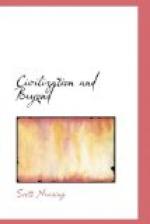The countryside is the goose that lays the golden eggs. The city gathers, guards and eventually consumes the eggs or converts them into capital forms and lives in part on this unearned income.
The city is the mecca which attracts by its wide ranging opportunities. It is also the center in which policies are made and offered to the countryside as normal facts of life. The countryside accepts city leadership including a higher wealth-power per capita ratio for the city.
Cities, with their accumulations of population and wealth, are walled or otherwise defended. When danger threatens, countrymen often move inside the walls until the danger abates.
Cities and city life increase and expand with the growth and expansion of civilization. Cities are the centers from which civilization grows and expands. Historically, a number of cities or city-states have competed for survival and supremacy. One by one they have dropped out of the race or have been out-classed, defeated and/or absorbed by the victors in the competitive struggle. One location proved to be more advantageous than others. The inhabitants of one locality were more skillful, more far sighted than those of rival localities. Many competed. Eventually one survived the final round of struggle, emerging as the nucleus of an expanding empire and a maturing civilization. A protracted conflict raging first in Italy and later in the entire Mediterranean basin, resulted in the Roman Empire and eventually in Roman civilization. A similar series of struggles, this time planet-wide, gave the British a taste of planetary supremacy in the nineteenth century and opened the door wide enough to give the United States oligarchy a glimpse of an American Twentieth century, which never eventuated.
Occupational differences within the city led to a differentiated class structure. As the trading city developed, businessmen eventually played a dominant role because they were able to command larger incomes, accumulate more wealth and offer more aggressive leadership.
Nuclei of both empire and civilization were associated with a cluster of allies, client states, dependencies and colonies related to the center by economic interests and by diplomatic bargains or political controls. They paid tribute or taxes as the price of living within the defense perimeter of the ruling elite, conforming to the chief aspects of its culture and in emergencies taking refuge inside the city defenses.
The city center made and implemented policy and provided local leadership in emergencies. Inhabitants of the city enjoyed a superior status and had a higher standard of consumer-living than most of those who inhabited the countryside and the hinterland.
A structured society based on division of labor and/or function enjoys a competitive superiority over a classless community. The structured city was not only richer than the countryside, but it was in a position to provide leadership, to plan and implement policy and act more effectively.




